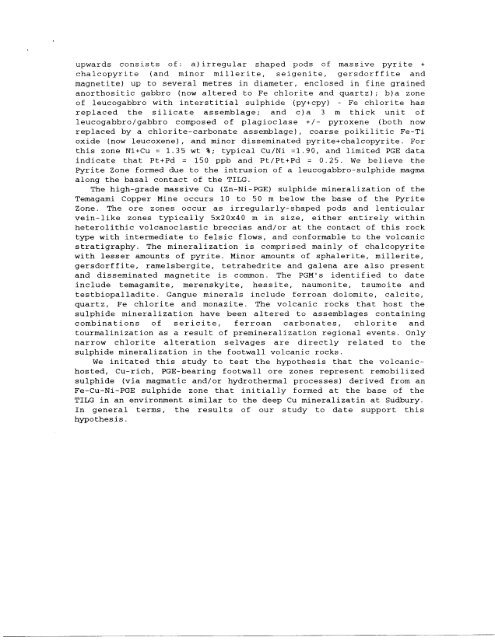Jessie Lake Property - Geology Ontario
Jessie Lake Property - Geology Ontario
Jessie Lake Property - Geology Ontario
You also want an ePaper? Increase the reach of your titles
YUMPU automatically turns print PDFs into web optimized ePapers that Google loves.
upwards consists of: a)irregular shaped pods of massive pyrite *<br />
chalcopyrite (and minor millerite, seigenite, gersdorffite and<br />
magnetite) up to several metres in diameter, enclosed in fine grained<br />
anorthositic gabbro (now altered to Fe chlorite and quartz); b)a zone<br />
of leucogabbro with interstitial sulphide (py+cpy) - Fe chlorite has<br />
replaced the silicate assemblage; and c)a 3 m thick unit of<br />
leucogabbro/gabbro composed of plagioclase +/- pyroxene (both now<br />
replaced by a chlorite-carbonate assemblage), coarse poikilitic Fe-Ti<br />
oxide (now leucoxene), and minor disseminated pyrite*chalcopyrite. For<br />
this zone Ni+Cu = 1.35 wt *; typical Cu/Ni =l.9Q, and limited PGE data<br />
indicate that Pt+Pd = 150 ppb and Pt/Pt + Pd = 0.25. We believe the<br />
Pyrite Zone formed due to the intrusion of a leucogabbro-sulphide magma<br />
along the basal contact of the TTLG.<br />
The high-grade massive Cu (Zn-Ni-PGE) sulphide mineralization of the<br />
Temagami Copper Mine occurs 10 to 50 m below the base of the Pyrite<br />
Zone. The ore zones occur as irregularly-shaped pods and lenticular<br />
vein-like zones typically 5x20x40 m in size, either entirely within<br />
heterolithic volcanoclastic breccias and/or at the contact of this rock<br />
type with intermediate to felsic flows, and conformable to the volcanic<br />
stratigraphy. The mineralization is comprised mainly of chalcopyrite<br />
with lesser amounts of pyrite. Minor amounts of sphalerite, millerite,<br />
gersdorffite, ramelsbergite, tetrahedrite and galena are also present<br />
and disseminated magnetite is common. The PGM 1 s identified to date<br />
include temagamite, merenskyite, hessite, naumonite, tsumoite and<br />
testbiopalladite. Gangue minerals include ferroan dolomite, calcite,<br />
quartz, Fe chlorite and monazite. The volcanic rocks that host the<br />
sulphide mineralization have been altered to assemblages containing<br />
combinations of sericite, ferroan carbonates, chlorite and<br />
tourmalinization as a result of premineralization regional events. Only<br />
narrow chlorite alteration selvages are directly related to the<br />
sulphide mineralization in the footwall volcanic rocks.<br />
We initated this study to test the hypothesis that the volcanichosted,<br />
Cu-rich, PGE-bearing footwall ore zones represent remobilized<br />
sulphide (via magmatic and/or hydrothermal processes) derived from an<br />
Fe-Cu-Ni-PGE sulphide zone that initially formed at the base of the<br />
TILG in an environment similar to the deep Cu mineralizatin at Sudbury.<br />
In general terms, the results of our study to date support this<br />
hypothesis.

















